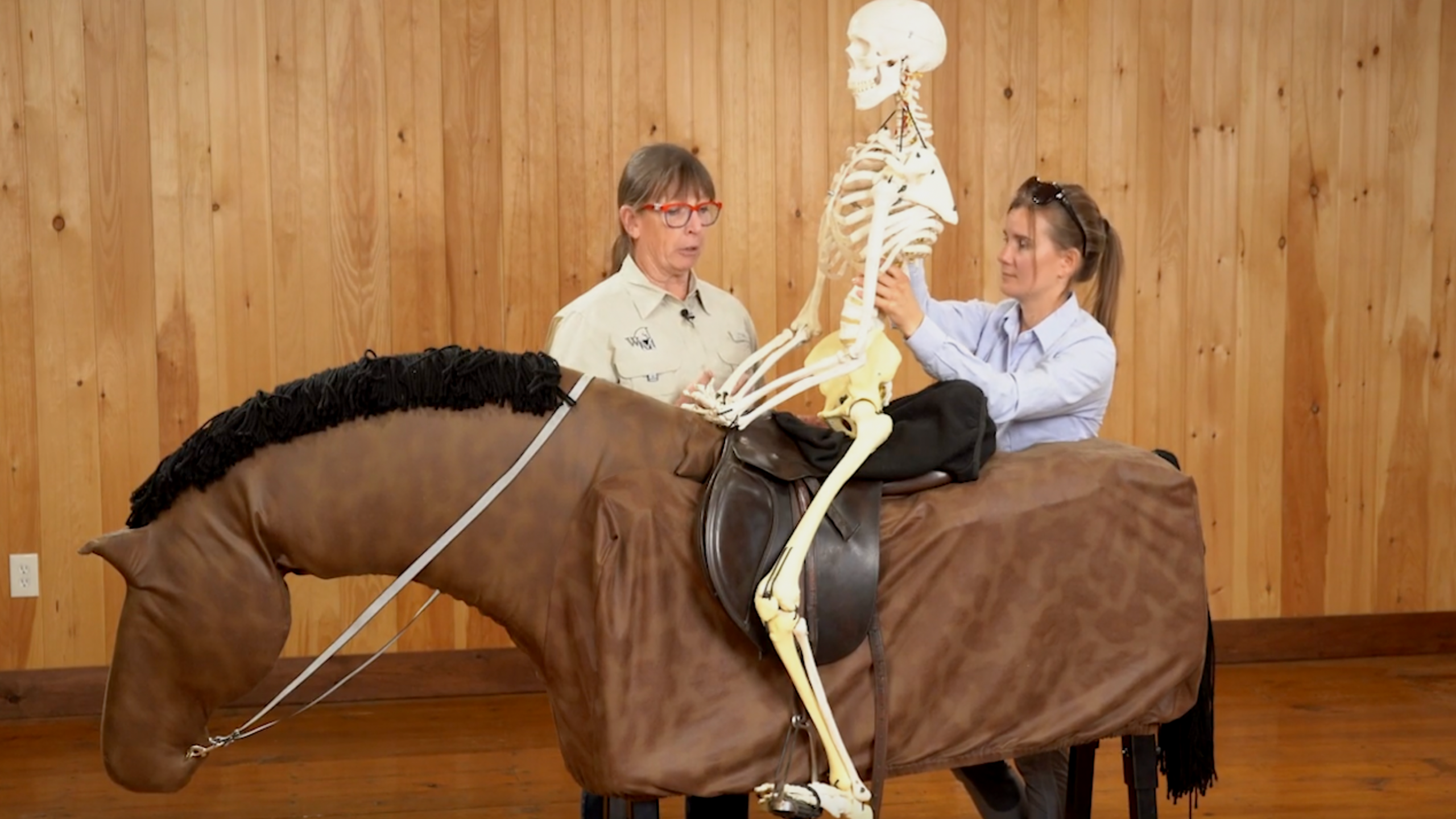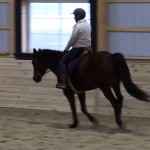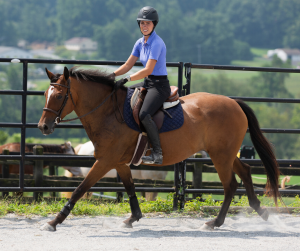There are many conflicting stories about how the canter should be ridden…
Do you scoop your hips?
Sit back to push the horse forward?
Lean forward and keep a light seat?
Or… just hang on and hope for the best?!
To clear up the canter confusion, in this week’s video I am here with Wendy Murdoch and Elmer the skeleton, to explain what our body needs to do at canter, how we can easily go with the horse’s movement, and why some things riders do makes them unstable and could even hurt the horse.
Click play below to learn more!














70 Responses
It did illustrate the concept of having the rider just sit, no posting, no scooping. The depart cue we all use twists us to start off. Oooh.
Thank you very much, this is Very Helpful
Yes. This demonstration reminded me I don’t have to work my body in canter if I’m well sat. The horse will do the job. Thank you
Absolutely! We often times do way more than we have to – the key is to let the horse move without getting in their way!
-Julia, HorseClass Community Manager
Let your horse start the canter. That is powerful.
Now how do we cue the host to move into canter.
Hi Ann, that will depend on the cue that the horse knows to pick up the canter.
-Julia, HorseClass Community Manager
What is the correct aid for canter? I usually lift the inside rein and use the outside leg.
MaryLou, is this a horse that is your own personal horse or a lesson horse? It depends what cue the horse has been taught.
-Julia, HorseClass Community Manager
These videos are a GIFT. I’ve ridden for nearly 50 years now, and I still learn from them! Thank you so much!
Glad you enjoyed the video Lisa!
-Julia, HorseClass Community Manager
Hi!! Thank you for this video it helped a lot. One question though! I’ve always been taught to ask for the right canter lead by bringing my hip forward like you showed, so how do I ask for the correct lead without doing that? Thank you!
Hi Carterann, you can click here to watch this video for tips on picking up the correct canter lead.
-Julia, HorseClass Community Manager
Good information. Good to actually see the movements with the skeleton.
Oh, Wendy. Thank you for giving me a skeleton to see what is happening! Elmer is brilliant!
One thing, I was able to see was why to keep my feet under me. I am a person, who when told to sit down, I ended up with my feet out in front of me.
You may be putting too much pressure on the stirrups DeAnna!
-Julia, HorseClass Community Manager
Hmm that was interesting,just starting to canter my boy under saddle,well having watched your video I may have more success,you’ve made me more conscious of how my body is going to either hinder or help him,he picks up the canter no problem online and I knew I was the issue,this has given me clarity,thank you.
Viv, I hope you’ll let us know how it goes with your horse!
-Julia, HorseClass Community Manager
What is Wendy’s cue for lead change if not the forward move of the pelvis?– otherwise this is very instructional and I will attempt to “relax and follow” the next time I ride the canter
It depends on the cue that the horse has been taught for the lead change!
-Julia, HorseClass Community Manager
Excellent presentation. I was especially interested in the explanation of inside hip forward as a canter cue, and its effects in a straight canter depart. I found this very enlightening. Thank you
On various horses I’ve been told to go into a half seat fro the upward transisiton to a canter. Are there tips for a smooth transisiton up to the half seat and down so that you don’t hinder the horse’s gait?
Hi Lindsay, we posted this video from a couple years ago about riding an effortless canter transition you can check that out here.
-Julia, HorseClass Community Manager
Wait for the horse to Canter you!… lightbulb! Thank you
Glad that was helpful Paula!
-Julia, HorseClass Community Manager
Thank you so much for this video. I fell off trying to canter a few weeks ago and I am trying not to be terrified to try again. This entire video helped me. I am going to try these techniques and hopefully I will be able to stay centered and balanced next time
I’m glad this video was helpful in rebuilding your confidence at the canter!
-Julia, HorseClass Community Manager
Very useful and clear presentation. I really liked the explanation of how leaning forward blocks the horse and how we should let the horse canter you instead trying to get the canter out of him.
Also enlightening was the tip to think of the transition as horse leg movement change and not speed change – I think it helps follow the movement better. Thanks!
I found the demonstration of leaning forward pushing the horse into the forhand so fascinating and explains why/how the ‘feel’ of the canter changes. As I’m working hard with getting my quarter horse to work from the hind end, I will be mindful of my position to encourage free movement of the back in canter. Thanks!
Your comment that you just go with the saddle clicked! While working in the round pen today I can see just how little the saddle moves and watching some ride that the movement should be minimal. Thanks!!
“Let your horse canter you.” Brilliant. That is something I can visualize and on my next ride that will be my thought and hopefully, my body will follow. I tend to try to ‘help’ my horse into the canter with my arms and upper body. This video will help me move with him!
I would like a similar demonstration on a smooth downward transition from canter to trot and canter to walk
Jane, we covered transitions in a separate video that you can check out here 🙂
-Julia, HorseClass Community Manager
This was very interesting. I can see how I have gotten in the way of my horse many times. I have been told to sit up, stop leaning forward – but never really told why. Now I know. Am keen to experiment on this today. It was good to learn visually.
“Let your horse canter you.” Brilliant. That is something I can visualize and on my next ride that will be my thought and hopefully, my body will follow. I tend to try to ‘help’ my horse into the canter with my arms and upper body. This video will help me move with him!
“Wait for the horse and let the horse canter you”. Now I understand what my trainer said that after I cue his ribs into a corner to immediately release the cue and ask for the lope. I tend to overthink, over cue, and confuse my cues; that’s when I always pick up the wrong lead. When I pick up the correct cue, I don’t remember what I did. I think I must have just asked for the lope and didn’t over think it. Does that make sense? Thank you Callie, Love your classes.
That does make sense Denise! I would love to have you check out this video on canter transitions that might help you with this problem.
-Julia, HorseClass Community Manager
Great video, wish I had seen this a while ago. I spent ages trying hard to figure out the canter, until someone finally told me to just lean back “like in a car seat” and relax, and I couldn’t believe how easy it was then suddenly, it just worked on its own!
We tend to make it more difficult than it needs to be Sam!
-Julia, HorseClass Community Manager
What about opening and closing the hip angle? That’s what I have been told to do.
Lynn, we covered this is a separate video. For the explanation you can click here to watch that episode of the blog.
-Julia, HorseClass Community Manager
I leaned how I’m blocking my horse.
When I’m in canter, I feel I’m being pushed up and unable to swing forward.
Thank you for this demonstration. My question is how you ask for the canter if you do not move your hips. Is it just the weight on one hip or the foot behind the girth?
Thanks a lot for your videos. I love them and I subscribed to the course Effortles Rider
Beatrice M.
Beatrice, we covered this in a separate video you can click here to watch.
-Julia, HorseClass Community Manager
great help. Each year after a very wet winter I have to start all over again and canter is the most challenging to begin again.
It was so good, Callie and Wendy you are so great. You always seem to come up with the very thing I am trying to sort out. I am one of those who tense if I am anxious. This was such a helpful video. Thank you so much.
How does this work with a horse who has very rough gaits.
I learned that pushing the inside hip forward is not very helpful for horse or rider. Let the horse canter you. I am really going to have to think this one through.
Thanks, this video made me understand why sometimes I am not able to make the horse canter from a seated position but am successful from a two-point position.
Unfortunately I am not able to get around bouncing on and off the saddle in seated canter – most likely my core and back are not flexible enough. Also I brace my feet in to the stirrup on the count of 1 during the 1-2-3 motion. This lifts me off the saddle and then with a bang I fall back to it.
But this video showed me what happens when I have this bad “behaviour”.
Glad this video was helpful Sathya!
-Julia, HorseClass Community Manager
I overdo the canter cues -tense-up/lean too far forward/throw myself back, squawk ‘CANTER!!!’ . No wonder my mare stotts or bucks! I first noticed how my body language and/or emotional level was copied by the horse when lunging (parelli 7 games style) and the horse copied my leap forward and up into canter with an enthusiastic leap!
Thank you for this useful demonstration !
I saw what happens when I lean forward (because I’m scared), but the most useful thing is the advice to let the horse go into canter by himself, and not try to push him into it. With a horse who is an ex trot-racer, I have to keep that strongly in mind and not twist my hips anymore…
I was wondering what you recommend as a queue to get your horse to canter? Otherwise I found the video very enlightening and can’t wait until tomorrow when I really try not the push my horse down by leaning forward when I desperately what him to lift himself up into a canter.
Hi Yvonne, you can click here to watch a video about canter transitions.
-Julia, HorseClass Community Manager
This video reinforces visually not to pitch forward as I will do sometimes, it’s blocking the transition and then even speeding the gait. Love the psychological explanation of how canter is the flight gait and that’s why we all struggle with it!
I’ve been taught to lead with leg by rotating hip to get different lead. Now I need to know how to get the lead change.
I go into a panic whenever canter is mentioned by my teacher. I have managed it previously on a very steady school horse who knows how to teach it! I was taught to hold the front of the saddle with my inside hand. Now on my own horse my new teacher says I’m not allowed to hold the saddle so I panic! I tried without holding a few weeks ago and it was a disaster! Any tips gratefully received
Thank you for this really helpful demonstration.
What is the best way to ask for the canter?
Hi Judy, we did a video on this several years ago. You can click here to learn the steps to riding an effortless canter transition.
-Julia, HorseClass Community Manager
Thank you for this. Canter has been one of my nemesis and now I am more confident I can work on getting the canter better. This was really clear and easy to understand and makes complete sense so I will be trying to let my horse canter me from now on.
Glad this was helpful Debbie!
-Julia, HorseClass Community Manager
Brilliant demonstration!! Thanx !!
You’re welcome Maria! I’m so glad to hear this demonstration was helpful 🙂
-Julia, HorseClass Community Manager
Wow! “Wait for the horse to canter you!” I once had a judge tell my trainer basically that I was working hard to canter for my horse. To be fair this was the first test after I had ridden the worst test of my life where I couldn’t get my horse to canter which made me frustrated and nervous which, of course, only made matters worse! It has never been intuitive how I block my horse’s movement although I can feel the difference of my horse’s reaction when I am positioned more correctly and not tensing. While I still don’t completely understand the physiology of it this visual with the saddle is priceless! Thanks.
Cheryl, we often try to do too much. Hope you can get a chance to practice this and feel the movement from your horse!
-Julia, HorseClass Community Manager
How helpful! Great advice.
Glad this was helpful David 🙂
-Julia, HorseClass Community Manager
Thank you for this helpful demonstration. Wait for the horse to canter you, it means I keep my hips and legs loose so I can follow the movement of the horse with my body
Glad this demonstration was helpful Fatima 🙂
-Julia, HorseClass Community Manager
This is the first time I’ve seen Joker in action. How is he used for teaching? I’d like to see a demonstration. And why the name “Joker”?
Sue, Joker is fantastic for allowing the rider to focus on their movement and function in the saddle without having to worry about all the other factors that happen when you are on a ‘real’ horse. There are fantastic examples of Joker and how the rider position impacts the horse’s ability for movement in Wendy’s ABCs to On the Aids course.
-Julia, HorseClass Community Manager
I had success cantering a school horse a little while ago and will soon be cantering a new school horse. It is so helpful to hear and see what is correct on any horse. Understanding what the horse’s body is doing makes all the difference for me. Letting the horse move your body works when posting, too. Letting the horse do that work frees me up to work on my posture and other aspects of riding correctly that is totally up to me.